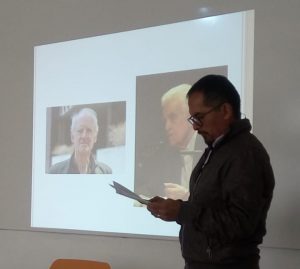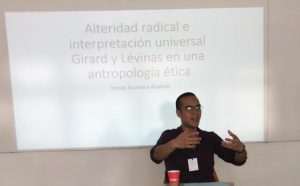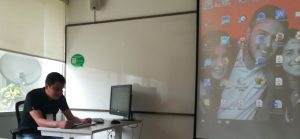
Contents
Letter from the President, Martha Reineke
Musings from the Executive Secretary, Niki Wandinger
Editor’s Column, Curtis Gruenler
COV&R Annual Meeting at Purdue University, Lafayette, Indiana, USA – POSTPONED
COV&R Sessions at the American Academy of Religion
Collaborators Conference presented by Theology & Peace and the Raven Foundation
Reflections on the Coronavirus Pandemic
From Monaco: A Question of Society and Self-identities, Helene Cristini
Truth, Balconies, and Mimetic Theory: A View from Valencia, Spain, David García-Ramos Gallego
From Melbourne, Australia: Everyday Heroism, Joel Hodge
Scapegoating in St. Louis, Missouri, Grant Kaplan
Moral Ambiguity in a Supermarket Parking Lot, Baltimore, Maryland, Stephen McKenna
From New York, New York: Am I My Brother’s (virus) Keeper? Marcia Pally
Holy Friday Meditation on COVID-19 from Bogotá, Colombia, Roberto Solarte
From Sydney, Australia: Mass on Media, Matthew Tan
Inter-American Congress of Philosophy
Bibliography of the Literature on Mimetic Theory, Dietmar Regensburger
Letter from the President
COV&R Virtual Conversations this Summer
Martha Reineke
University of Northern Iowa
As I previously shared with the membership in April, our summer annual meeting, scheduled for July at Purdue University, has been postponed until the summer of 2021 (see the note below). I would like to express my gratitude to our hosts, Sandor Goodhart and Tom Ryba, for looking out for the safety of COV&R members as they assessed the issue this spring and worked with Purdue University to postpone the meeting. I want also to express my profound appreciation to Roberto Solarte and his colleagues for being willing and able to move the 2021 conference they are hosting to 2022. We have such rich opportunities for COV&R at Purdue and at Javeriana University in Bogota that losing either of these would be a profound disappointment.
While we await the opportunity to be together again, we have much on which to reflect. Curtis has worked to initiate that reflection with the current issue of the Bulletin, which gives us a thought-provoking introduction to the many ways that mimetic theory can insightfully illuminate the COVID-19 pandemic. Below, I outline a process for submitting proposals for virtual conversations this summer, to be held in lieu of the annual meeting. These sessions will offer robust opportunities to examine COVID-19 in light of mimetic theory and to reflect in new ways on mimetic theory as we employ it to analyze COVID-19.
The Board invites our membership to create and offer virtual sessions between June and August on “mimetic theory and COVID-19.” These conversations will be a wonderful way to sustain and support our COV&R family during this difficult time. You may want to offer a session on something by Girard or by someone working in mimetic theory. Perhaps a recent book or article has struck you as inviting responses from the perspective of mimetic theory (see Curtis’s idea for a session in the editor’s column below). A discussion of a film is also possible. Creativity is welcome in imagining potential sessions of interest to the membership.
These sessions also can be opportunities to invite persons unfamiliar with mimetic theory to participate in a conversation with us for the first time (though session organizers should be COV&R members). Sessions should not entail the purchase of resources and therefore will not require registration fees.
Here are the guidelines to discuss in your proposal:
- Host (in charge of communications, signups, etc.)
- Single or multi-session?
- Synchronous/Asynchronous?
- Proposed date(s) and time. Please use a meeting time zone calculator and try to include at least two of the following time zones in selecting a meeting time: Melbourne, Australia; Innsbruck, Austria; and St. Louis, MO. Here is a link to a time zone calculator.
- Second choice date(s) and time
- Platform with maximum number of participants (e.g., Zoom, Skype)
- Session content description (no more than 300 words)
- Session format (e.g., group discussion, panel with respondents)
- Resources (e.g., predistributed paper, article, book chapter, etc.)
Please submit your proposal to Maura Junius by Friday, May 29. If your proposed session is for June, please submit it earlier than that date if possible. Proposals will be reviewed quickly and session information will be shared with the membership.
I want to strongly encourage each of you to host and/or participate in one or more sessions. Why? As I survey the US landscape, I find that mimetic theory has seldom been more vital as an analytical resource for helping us to understand a contemporary issue. And likewise, for most of us, the pandemic offers a singular opportunity to press forward with mimetic theory, to ask more of it as a toolset for reflective inquiry than we have previously in order that we may draw on mimetic theory to identify and address the true depths of the threat the virus poses to human community.
One of several “breaking points” in the crisis that has emerged in the last couple of weeks, as US citizens have begun to leave our homes and venture out, is “to mask or not to mask.” For individuals living in states whose governors have not made masks mandatory in public, masks are a flash point generating, in some cases, physical altercations. Notwithstanding that health experts point to masks as a key resource for lowering transmission of the virus, only 30% of individuals in my state are wearing masks, despite a rising rate of infection and death that has paralyzed the key industry in the state—meat processing—and beset a majority of nursing homes.
This week I listened to an Iowa Public Radio interview with Alison Phillips, an associate professor of psychology at Iowa State University whose research specialization is social psychology. She discussed the fraught social scene in which every trip to the grocery store not only poses challenges for social distancing but also raises interpretive hurdles. What meanings are mask wearers assigning to those who are not covering their faces and vice versa? Phillips offered a number of suggestions, of which two resonate with particular clarity for mimetic theorists. Persons who are not wearing masks, she said, are wary of being labeled “ill,” “weak,” or “a victim.” Finding unbearable the prospect of a gaze that would position them in a diminished role, they refuse to cover their faces, often citing reasons seemingly unrelated to their feelings of vulnerability, most often “individual rights.” Some researchers, noting a significant gender gap between the mask wearers and refusers, link the refusers’ stance to an ideology of toxic masculinity. One man told an Arizona reporter that a face mask signals “submission.” Another stated, “It looks weak, especially for a man.” Still another has described mask wearers as “cowards.”
Are mask wearers “weak”? Research shows that significantly higher percentages of women wear masks. Persons with pre-existing health conditions seem to be wearing them in greater numbers. An Asian-American woman wearing a mask was attacked last month in a subway station in New York City after being charged by her attacker with spreading the coronavirus. Mimetic theorists recognize in someone who refuses to wear a mask because they don’t want to be labeled weak a proactive rejection of the role of a scapegoat. Yet, especially as exemplified by the US president and vice president, projective refusal of victim-status reverses the dynamics of actual social scapegoating. It insists the others sacrifice themselves.
If the options are to wear a mask and thereby bear signs of the vulnerable victim of the virus or to join in the mask refusers’ symbolic demonstration of invincibility, mask wearers risk actual disempowerment and victimization. By way of example, when community leaders met with Vice President Pence last week in Des Moines, IA, Pence’s advance team told them to remove their masks. Pence did not want photos from the meeting to convey a message of danger and disease. Why did meeting attendees, some representing the most vulnerable populations in the state, comply with that request? If they had refused, they would have ceded their one opportunity to advocate for their constituents with the Vice President. They accepted the health risk to themselves and others of appearing with Pence (whose press secretary tested positive for COVID that very day) because the alternative was an even greater loss of standing that would further secure their helplessness and that of their constituents in the presence of the virus. If they did not comply, they would not have been able to make a pitch to Pence for federal funds they hoped to receive.
In a culture where victim-status is the moral high ground, as illuminated by mimetic theory, the impasse between mask wearers who desire to preserve their own health and mask refusers who desire no constraints on their behavior deepens into a competition of altruistic selflessness. Who cares more for the vulnerable, mask wearers who seek not to spread the disease or mask refusers who, in the war language recently adopted by President Trump, hold forth that “we” must be prepared to make “the ultimate sacrifice” by opening the economy up, even at risk of dying from the coronavirus? Yet, persons who actually are among our most vulnerable—workers who keep essential functions in play at the bottom of the economic pyramid—are disproportionately black, brown, and poor. They, who welcome masks but find too frequently that their employers have no personal protective equipment for them, are on the front lines and are most likely to fall victim to the virus which is scapegoating them, putting them and their contacts most at risk of making “the ultimate sacrifice.”
Is there a place for positive mimesis (intimate mediation) in the time of a pandemic? Psychologist Phillips shared interesting data from mask wearers. When she asked why they wear a mask, they seldom offered as a primary answer a desire to protect their own health. Nor did they regularly cite a family member whose health they were primarily concerned about. Rather, they talked of “doing their part” to slow community transmission in order to protect persons they did not know and would never meet. Some mimetic theorists may want to explore through a mimetic lens ways in which “doing their part” for a community opens up interdividuality within the context of positive mimesis.
I share this sketch of a mimetic analysis of the impact of COVID-19 in Iowa in order to affirm that no one of us is sitting out this pandemic. All of us are both living with it and experiencing its disruptive and dangerous features. And we are likely to find ourselves reflecting in real time on how mimetic theory sheds light on that experience. I encourage each of you not to keep your thoughts to yourself. Girard introduces his book The Scapegoat with a discussion of plague. Plague is again amongst us, and mimetic theory has much to contribute to how we respond to this crisis. Your participation in this summer’s virtual conversations can help create and preserve mimetic theory’s important contributions.
Musings from the Executive Secretary
The Gift of Meeting Face to Face
Niki Wandinger
University of Innsbruck

As I do not consider myself as having the gift of prophecy, I will refrain from speculating about the long-term consequences of the corona crisis and the very different reactions to it. It remains to be seen what will be the lessons from the pandemic really learned and what are just whims of the moment. Instead, I’d like to relate a few thoughts on something the pandemic has already affected which is directly related to our Colloquium: the postponement of this year’s Purdue conference to next year and all the changes following from that.
As head of the team that organized the 2019 conference in Innsbruck, I can very well imagine how hard this decision was for those who prepared for the 2020 meeting at Purdue. I commend them on their prudent and carefully taken decision to postpone. Like so many restrictions we endure for the sake of safety—our own but even more that of those more vulnerable to COVID-19—this also makes us realize the value that we are giving up temporarily for the sake of an even higher value.
Let me do this in a very personal way, as it so happens that my very first COV&R conference in 2002 also took place at Purdue. I was in the final phase of completing my doctorate, and my colleagues Wolfgang Palaver and Józef Niewiadomski urged me to come along with them to do a plenary session on “The Work of Raymund Schwager on Christian Scripture.” So, one of my first impressions of COV&R was that they accepted a newcomer, who had not even finished his doctorate, to speak to the whole auditorium just on the word of two accomplished members. And they welcomed this newcomer very warmly: René Girard was as accessible as any other member of the Colloquium, and the always socializing and humorous Rusty Palmer immediately made me feel at home. Raymund, René, Rusty—these, in very different ways, important persons for COV&R have all left this world since then and we have made do without them, and we managed to do so—not without experiencing great loss. It testifies to the strength of the ideas embodied in COV&R that we could progress and thrive without those and many other important figures who have left us to our sorrow.
But could we do so without physical presence at conferences for a longer period of time? I am quite doubtful about that. Direct discussion and exchange are an elixir of life for the Colloquium. Written question and answer sessions or virtual exchanges through the internet could not replace them without effecting great loss. One of the strengths of the Colloquium is that through mimetic theory we are able to work across many fields of specialization and expertise. We do not only attend talks by colleagues with the same specialization but we bridge and cross-reference those fields. If our conferences were to deteriorate to everyone listening in to their own specialty alone and leaving the rest to themselves, the interdisciplinarity of the Colloquium would evaporate. Yet it is hard to imagine how one should manage to stay at one’s own university or other institution and take out three full days in a row to follow so many diverse online presentations. And even if the time were expanded and the density of the talks reduced—say to several weeks—we would still be at our home institutions and be hard pressed to carve out the time needed for the conference.
And this is just the “academic” part. What about the socializing part? One might be tempted to say that the socializing part was gratuitous, that we could do without it for the sake of the environment, and that it was not professional anyway. I would object. First, being a theologian, the term “gratuitous” has a special ring for me. It can signify the superfluous, unnecessary and expendable; however, for Christian thinking, “grace” is also gratuitous, meaning that it is given for free; but it is not superfluous or expendable at all. Rather it is the heart of things without which all labor is in vain. It is a free gift but without that gift all else is anxious toil (as the Psalmist says). It cannot be commanded but there are circumstances that make it easier to come by.
I would argue that the personal encounters at COV&R meetings are gratuitous in that sense: they do not seem essential in a logic of practical rationality; yet they are absolutely central to how the Colloquium works. Personal encounters at our meetings are not always and only sweet and beautiful. We experience mimetic mechanisms right among ourselves. It shows that even those who reflect and analyze these mechanisms are subject to them. It tells us firsthand how powerful they are – for bad but also for good. The heart of the research that we conduct in the Colloquium is not just in papers and presentations but in these personal encounters in all their problems and their beauty. These personal encounters and how they work out cannot be commanded either, but we can arrange circumstances that enhance them or that hinder them. Abstaining from meetings in physical presence for longer periods would be a great hindrance to that kind of gratuity. There are ways to limit environmental damage without erecting that hindrance.
So, I am really looking forward to Purdue 2021 and all our future meetings.
Editor’s Column
A Time for Reflection
Curtis Gruenler
Hope College

Mimetic theory is always an aid to reflection, and the COVID-19 pandemic is giving us extra cause and, perhaps, space to consider where we are. I want to thank the authors of the pandemic reflections in this issue for taking up the invitation to write from where they are. Building on their thoughts—especially Roberto Solarte’s closing words—I would like to extend a general invitation to members to write similar reflections for the August issue of the Bulletin. While you are welcome to look back on the experience of the pandemic in your location, I want to encourage you to look ahead. How does this crisis present opportunities for change? How might mimetic theory help us imagine and turn toward better ways of being together? I’m hopeful that the pandemic will help move us toward environmental sustainability, but more difficult to imagine are the kinds of social and relational change for which the COV&R community has unique insights, as suggested by the Raven Foundation’s nifty video, Flatten the Curve on Violent Conflict.
In a column for the May 18 issue of Time, the Dutch historian Rutger Bregman, whose forthcoming Humankind: A Hopeful History emphasizes our “unique ability to cooperate,” offers this thought: “The age of excessive individualism and competition could come to an end, and we could inaugurate a new age of solidarity and connection.” But mimetic theory shows how our most stable and persistent forms of solidarity are in fact formed by the same forces that drive individualism and competition, and, behind that, how our proclivities for both cooperation and rivalry stem from the same mimetic capacity. Yet Girard’s work and studies of the human cooperation are too often set in opposition. Mimetic theory provides an essential key for actually distinguishing competition and cooperation—for choosing forms of cooperation that are not covertly grounded in scapegoating, and for recognizing their fragility.
When my college shifted to teaching remotely this spring, I had just begun rereading The Lord of the Rings with students in a course on J. R. R. Tolkien and medieval literature. Most of us found it comforting and salutary in its models of “choosing hope, compassion, and perseverance in the face of darkness,” as one student put it. Even more important, I think, are its models of the kinds of relationships we need—friendship is the word Tolkien uses over and over again—in order to face a crisis well. I have spoken about this before and hope to write more, but for now I simply want to echo Girard’s point about the unparalleled value of literature for learning how to be persons in relationship, and to invite you to write also about your reading during this time.
Your reflections could also build on the virtual conference sessions that COV&R is organizing for the summer—see Martha Reineke’s letter above. I am thinking of proposing to host a discussion of Paul Ricoeur’s book The Symbolism of Evil. I turned to it to help me think about the contrasting approaches to myth in Girard and Tolkien but have found it to be complementary to mimetic theory in many other ways as well, such as its critiques of “original sin” and the project of theodicy. Watch for more details when the virtual sessions are announced in early June.
If you would like to write something for the August issue, please let me know. Or even better, write something for a wider audience and send me a link when it is published.
Publishing news: Members should by now have received The Oedipus Casebook: Reading Sophocles’ Oedipus the King, edited by Mark Anspach, which puts Girard’s ground-breaking interpretation in the context of a wide array of authoritative scholarship. We plan to publish a review of it soon. If you know of a classicist who might be interested, consider inviting them to write a review of it for one of their professional journals; Michigan State University Press would be happy to provide a copy. Per Bjørnar Grande’s Desire: Flaubert, Proust, Fitzgerald, Miller, Lana Del Rey is scheduled for July in the series Breakthroughs in Mimetic Theory and Marie Delcourt’s Oedipus; or the Legend of the Conqueror for August in Studies in Violence, Mimesis, & Culture. Next season will bring Giuseppe Fornari’s two-volume Dionysius, Christ, and the Death of God: volume 1, The Great Mediations of the Classical World, and volume 2, Christianity and Modernity.
Just out this month from Bloomsbury are Conversations with René Girard: Prophet of Envy, edited by Cynthia Haven and James Alison and a Girardian Theology: Conversion, Theological Reflection, and Induction by John P. Edwards. And two new titles are due out this summer in Bloomsbury’s series Violence, Desire, and the Sacred: Tragic Novels, René Girard and the American Dream: Sacrifice in Suburbia (great title!) by Carly Osborn later this month and, in August, a paperback edition of Mimetic Theory and Film, edited by Paulo Diego Bubbio and Chris Fleming. Order them all for your library!
Another new publication worth knowing about is the remarkable video series on mimetic theory by COV&R board member Erik Buys for his website, Mimetic Margins.
Finally, we haven’t had a new installment of the bibliography in a while, but Dietmar Regensburger has made up for lost time with generous list of new publications on mimetic theory. As a reminder, most of the previous installments have been added to the searchable Index Theologicus. This link, also found on the bibliography page of the COV&R website, will retrieve pieces on Girard or published in Contagion.
Forthcoming Events
COV&R Annual Meeting at Purdue University Postponed to 2021
Sandor Goodhart and Thomas Ryba

We are writing to update you with regard to the COV&R conference that was planned for July 8-11, 2020. As of May 15, we received the official notification that all summer activities of the kind that we were planning at Purdue University have been canceled. This cancellation is of course not a surprise to any of us and we hope you are well this very strange pandemic season. As we announced previously, any funds that spent for registering or for on-campus accommodations will be or already have been fully refunded. Please be sure that if you made any personal reservation for hotels in the area that you cancel those reservations on your own.
We have also received word that all conference space that was reserved for this year has been reserved for next July 7 to 10, 2021, at Purdue. Barring a second pandemic wave next winter and an additional shut down, our hope is that the COV&R 2021 conference will proceed as originally planned for 2020. One slight additional positive note: the construction on the campus hotel that prevented us from reserving it this year has apparently been completed, and our liaison at Purdue Conferences has reserved for us a limited number of additional rooms that are directly on campus in the Purdue Memorial Union. More information on those reservations will be forthcoming.
We will of course keep you updated as more information becomes available to us regarding any of these matters. But as of the present, we look forward to seeing all of you and hearing your presentations in July, 2021.
COV&R at the American Academy of Religion
Boston, Massachusetts, Nov. 21-24, 2020
Times and locations to be announced.
Session I: Beyond Scapegoats: Marginalized Voices in Conversation with René Girard
Convener and Moderator: Grant Kaplan, Saint Louis University
- Julia Robinson Moore (The University of North Carolina at Charlotte), “Mimetic Theory through the Voices of the Little Rock Nine: Black Scapegoats in the Desegregation of Central High School, 1957-1958.”
- Martha Reineke (University of Northern Iowa), “An Escalation to Extremes: Purity Spirals and Victimization.”
- Chelsea J. King (Sacred Heart University), “Girard, the Feminist? Bringing Mimetic Theory into Dialogue with Feminist Critiques of Sacrifice”
Session II: Mimetic Theory and Christian Spirituality
Convener: Grant Kaplan, Saint Louis University
Moderator: Brian Robinette, Boston College
- Jared Price (Multnomah Biblical Seminary), “‘All Shall Be Well’: Julian of Norwich, Rene Girard, Jacques Lacan, and the ‘Other Side’ of Christian Mysticism”
- Aline Lewis (Graduate Theological Union), “Mimetic Desire in Ignatius of Loyola’s Autobiography”
- Joseph Rivera (Dublin City University), “Eucharist as Contemplative Action: A Girardian Perspective”
Co-Sponsored Session with Nineteenth-Century Theology
Academic Rivalry in the Modern Age: Thinking with Girard and Beyond
Convener: Zachary Purvis
- Grant Kaplan (Saint Louis University), “Brothers or Enemies? Revisiting Academic Rivalry in the Möhler/Baur Debate”
- Bryan Wagoner (Davis and Elkins College), “Franz Overbeck and Carl Albert Bernouilli Through the Lens of Girardian Mimetic Rivalry”
Respondent: Johannes Zachhuber (University of Oxford)
Online, August 10-14
A collaboration between The Raven Foundation and Theology & Peace, the conference combines keynotes, panels, breakout sessions, and networking opportunities to empower you with actionable tools and resources to apply mimetic theory and nonviolent Christianity and help make positive changes in your community and strengthen your faith. Speakers will include:
- Kevin Miller, director of the films “Hellbound?” and “J.E.S.U.S.A”
- David Dark author of Life’s Too Short to Pretend You’re Not Religious
- Julia Robinson Moore
The Collaborators Conference has been rescheduled as an online summit! Registration will be opening up in June, and the conference will be August 10-14, 2020. Stay tuned for more details.
Reflections on the Coronavirus Pandemic
From Monaco: A Question of Society and Self-identities
Helene Cristini
 A tiny microorganism called virus (in Latin contagium vivum fluidum, contagious slime) has been strong enough to bring the world economy to its knees and threaten the lives of millions, taking the lives of 294,155 people worldwide. If the virus started in China in Wuhan in 2019, it gradually contaminated the rest of the world, but above all caused Europe and the United States, the two continents “most powerful in the world,” to shudder. No need to see a conspiracy organized by a third country, retributive punishment of nature, or a divine punishment: humanity manages very well on its own to bring about all types of imbalances and provoke all the major crises that assail us today, as René Girard clairvoyantly explains.
A tiny microorganism called virus (in Latin contagium vivum fluidum, contagious slime) has been strong enough to bring the world economy to its knees and threaten the lives of millions, taking the lives of 294,155 people worldwide. If the virus started in China in Wuhan in 2019, it gradually contaminated the rest of the world, but above all caused Europe and the United States, the two continents “most powerful in the world,” to shudder. No need to see a conspiracy organized by a third country, retributive punishment of nature, or a divine punishment: humanity manages very well on its own to bring about all types of imbalances and provoke all the major crises that assail us today, as René Girard clairvoyantly explains.
How each country reacts to the crisis is worth observing. Crisis reveals what is hidden. A country struck by fate, like a being of flesh and blood, reacts mainly according to its inner resources. Let us take a quick look at France and the United States.
When President Macron solemnly addressed the French on television in March 2020 to discuss the pandemic and the reasons for the lockdown, he used the same sentence as his predecessor in the aftermath of the terrorist attack of November 13, 2015, “We are at war.” With these four words, the tone was set and fear could freely win everyone, “according to each his resilience.” France was almost immobilized. For two months, the state stood at the bedside of all economic agents. “There are no examples in the past of such massive aid from the state to households and businesses,” Pascal Peri, economist, reported.
However, French malaise exists. The French are said to suffer from the spoiled child syndrome. All benefits are perceived as due. Worse, the public services of the state, and of the local authorities, cautious and frightened by the virus, did not bring the original support of the civil servants to the service of the national and territorial communities. Too many families with children, young people with disabilities, and retirees were left alone because of the lack of civil servants willing to perform their function. Many workers made use of their right of withdrawal (droit de retrait) citing the mental stress they incurred, despite the fact that physical and health distancing measures were guaranteed. Today in mid-May, the second day of easing the lock down, there remain problems with public transport and the opening of schools, et cetera. The “quarrelsome French” sees the virus everywhere and rebel at the idea of going back to work by brandishing their freedom not to work, forgetting Kennedy’s phrase, more pertinent in France than where it came from: “Ask not what your country can do for you, ask what you can do for your country.”
While part of France is reluctant to return to work out of fear or too high self-esteem, an apparently opposite situation occurs in the United States. Perhaps under the conservative influence of President Trump but also under that of the media, not to mention the social media, more and more governors are reflecting on how to reduce the restrictions on the lockdown in the face of certain citizens frustrated by the economic downturn—while the country holds sadly the highest record of victims of coronavirus. In such a climate pushed by “anti-lockdown” demonstrators meeting to challenge the lockdown regulations, more and more are asked to return to work as soon as possible. Here too, the most vulnerable, such as the African-American minority, are suffering the most deaths per capita from the pandemic.
What do these two scenarios reveal to us? At first glance, two identities (France, United States) seem to be opposed. Yet we are faced with the same radical identity which has lost the will to live together and is detached totally from any inclusive perspective. This identity is separated from the other, from “we.” The common good is sacrificed for the benefit of the almighty self. Ontological disease is rampant everywhere, just as much as the coronavirus, and has equally infested the person. Dostoevsky spoke of the underground man, that is to say the one filled with resentment who knows no borders. Finally, if there is a war, the enemy is not “the other” but rather oneself, and his or her hubris. It will be necessary that each of us “prevents oneself,” in the depths of ourselves, in order to overcome all the crises, as Albert Camus, evoking his father, observed: “No, one prevents oneself, or otherwise…”—knowing that at this depth, it is essential that everyone is co-owner of the common good and co-producer of the decisions.
Truth, Balconies, and Mimetic Theory: A View from Valencia, Spain
David García-Ramos Gallego
 Pandemics are a matter of numbers and percentages. What has surprised me the most during this time is the great amount of data that we have been able to handle in real time. When we hold the postponed annual meeting of COV&R at Purdue, dedicated precisely to artificial intelligence and desiring machines, it will be interesting to discuss how it is possible to think reality through data with the help of the AI, those magic algorithms.
Pandemics are a matter of numbers and percentages. What has surprised me the most during this time is the great amount of data that we have been able to handle in real time. When we hold the postponed annual meeting of COV&R at Purdue, dedicated precisely to artificial intelligence and desiring machines, it will be interesting to discuss how it is possible to think reality through data with the help of the AI, those magic algorithms.
On the coronavirus there is data, there are mountains of data. This seems to be the only truth President Pedro Sanchez knows, who, during the weekly alarm status balance appearances, fires numbers and more numbers, as if the data were a barrier to contain the unknown. With so much data it is difficult to make assessments that are correct. Statistics has become the mother science of all sciences, with its own prophets, interpreters of the divine message sent by the data, the percentages, the curves, the predictions.
Socrates, at the beginning of his first speech in Plato’s Apology, says that he wants to tell the truth and that he trusts that what he says is just (pisteio gar dikaia einai a lego). Justice as the foundation of truth, therefore. But what justice—and therefore what truth—can we draw from these prophets of disaster that seem to abound today, in these times of pandemic? Or what truth are we talking about? Well, the truth that seems to be the only kind of truth that interests us: the truth of the madmen, the murderers, the expelled, the sacrificed, the detritus of society in the words of Zygmunt Bauman, in a prescient conference in 2005—“the waste of modern progress.” Now, how does this truth come to us? Let me be clear, frank, and direct—for perhaps not truthful: it comes directly from the victims in general. To grab truth understood as power, we need scapegoats. That is to say—you will forgive the baroque figure—the truth that tells us who is guilty of what is really happening, where by “guilty” we mean “victims.” By lynching, we are venting the frustration we feel at not going out, not having our freedom, not having access to many of our possessions—secondary residences, cars, offices, sports center memberships, clinics, and a long et cetera—everything done for the common good. Sacrificing our freedoms for the common good does not seem to be enough, we need to sacrifice someone else: the Chinese, the Italians, the Fallas, the May 8th demonstrations, the VOX rally, politicians skipping quarantine, the businessmen who lay off, the teachers who do not take into account the technological gap for some families, the neighbor of the 6th who plays the Spanish anthem at 8pm every day, the neighbors upstairs who make so much noise—what a lack of solidarity! All of them have been “lynched” by some and by others throughout these weeks. The real pandemic, the one that lurks behind any plague, any social or metaphysical disease, is the mimetic pandemic—the mimetic capacity for accusation.
That “mimetic pandemic” has found a way of expression on the balconies, where we have gone out to applaud from the first day at 8 pm. We paid tribute to all the heroes of this war: health professionals, security forces, food professionals, and a long et cetera: fallen in combat. We applauded our older and younger people for staying home for two months: not going out for anything, or almost anything. At the same time, however, those same people, from those same balconies, have protested by beating pots and pans –“caceroladas”– against each other; from those balconies we have symbolically lynched kings, as if the monarchy were to blame for this; the President, as if we were sure that anyone else in power would have done better. But we have also lynched the neighbor who was walking down the street carefree, who was desperately taking his children for a walk. We have created some neologisms, “balcony police” and “balconazi,” which reflect the mimetic wisdom that exists in all cultures, a wisdom that will soon be méconnué, forgotten. Polarization, most of it caused by politicians and worried citizens, has reduced politics to a speech of rival sides.
We run the risk of falling into what Agamben could call a permanent state of emergency: the permanent surveillance of society with the uncertain threat of an intangible risk. Fear plays a fundamental role. This pandemic has shown us a truth that has been little explored from the point of view of mimetic theory, and which we should explore: solidarity balconies coexist with Bentham’s panopticon. The most exalted health professionals’ sacrifice coexists with measures that can be considered eugenic when having to choose, following exclusively utilitarian criteria, who to attend to—for example, by reason of age. The bad mimesis, the collective behavior, the phantom of the ego agitated by populists and fascists, coexists these days with the good mimesis, the positive mimesis, that of the converted who knows he is guilty and who puts all his efforts into caring for the other, into obeying the law in a Socratic way, into keeping his anger in the knowledge that it is as unjust as the anger that the other exhibits, if it leads only to an accusation that seeks his own salvation. The truth is that holiness –understood in mimetic terms– lives hidden in the small true gestures of true justice.
Does this mean that we must lose hope? No, far from it. It simply means that in order to act in this context we have to be able to “see” that the worst is yet to come, that it is our responsibility to believe it and act accordingly and that, paradoxically, believing that, that the worst is yet to come, that it will become a reality, will be the only thing that will prevent it, that it is already preventing it. Because the worst is already here, coming. Girard closes his last book, Achever Clausewitz, with the following words: “vouloir rassurer, c’est toujours contribuer au pire” (seeking to comfort is always to contribute to the worst). The prophet is the one who disturbs, the one who brings us out of our quietness. Paradoxically, in these moments of self-isolation (closure) and stillness, these contemporary prophets ask us for metanoia, change of thought, conversion. Dupuy in his Petit métaphysique du tsunamis quotes in this sense Gunter Anders, the prophet of the nuclear catastrophe. Another Jewish philosopher, Hans Jonas, in his The Imperative of Responsibility, tells us: “It is the rule, stated primitively that the prophecy of doom is to be given greater heed than the prophecy of bliss.”
From Melbourne, Australia: Everyday Heroism
Joel Hodge
 It has been remarkable to see a physical contagion such as the COVID-19 pandemic rapidly become a social contagion and crisis—through panic-buying, constant blaming, and violence against health care workers and those deemed infectious (e.g., persons of Chinese ancestry). According to René Girard, this is a common trajectory.
It has been remarkable to see a physical contagion such as the COVID-19 pandemic rapidly become a social contagion and crisis—through panic-buying, constant blaming, and violence against health care workers and those deemed infectious (e.g., persons of Chinese ancestry). According to René Girard, this is a common trajectory.
In Violence and the Sacred, Girard identifies how physical diseases and epidemics commonly result in social or sacrificial crises in human societies. These crises are characterised by frenetic social or mimetic behaviours in which people fear contagion and impurity. Girard gives the Greek myth of Oedipus as an example. Oedipus was the king of Thebes, who, despite his power, was expelled from the city because he was accused of being the cause of a plague. Girard identifies how the “plague” became a social contagion which was “cured” by the “impure one” being expelled.
While modern societies are scientific in addressing pandemics, people still react imitatively, often resulting in violence. For example, panic-buying of items such as toilet paper became common in numerous places. Despite supplies of toilet paper being regular and sufficient, some people even fought over it in stores. Once the panic subsided, however, some wished to return to stores the extraordinary amounts of toilet paper they had purchased.
What explains such behaviour? A supermarket employee put it like this: “The question on everyone’s minds at work: Why are they buying everything? One customer summed it up: ‘Because everyone else is.’” Steven Taylor, an expert on the psychology of pandemics, says that panic buying is a sign of human herd behaviour common to pandemics: “It always happens. It’s a kind of a mass hysteria.”
Girard provides a scientific explanation for this kind of hysteria and herd behaviour: it occurs because humans are sophisticated imitators, driven by the mimetic nature of their desire. Human desire is not structured by mythical “individual preferences” or primarily by pre-programmed instincts but by what they perceive others want (mimesis).
During social contagions, human desire intensely fires from multiple points of stimulation, such that it is difficult to resist. As people act on their mimetic desires, they compete with others, which validates such desires in a perverse feedback loop. Girard remarks (I See Satan Fall like Lightning, p. 10): “In imitating my rival’s desire I give him [or her] the impression that he has good reasons to desire what he desires, to possess what he possesses, and so the intensity of his desire keeps increasing.”
Such desire intensifies even more if the objects of desire become scarce. Under such intensification, acquisitive desires and behaviours multiply. These lead us to de-humanise others and become violent. As a supermarket employee stated: “We were being bombarded daily with abuse from the public. They were talking to us like we weren’t even human.”
Most shocking of all has been the abuse and violence against health care workers. For example, the New South Wales Nurses and Midwives’ Association reported that a pregnant midwife was abused at a Macdonald’s restaurant in Sydney: “When showing her ID for a free coffee, a driver behind her yelled that she should not be spreading the virus.”
This kind of behavior is even harder to understand than hysterical panic-buying, at least in a moral sense. It is not a rational response—the medical worker is low risk. Rather, it is a social response, driven by the same mimetic dynamics as the panic-buying. Vulnerable people, who are accused of being contagious, are targeted and scapegoated by groups acting mimetically, so to make themselves feel better, united and in control.
Girard identifies how, in a social crisis (even one with roots in disease), humans are commonly driven by a fear of contagion—whether rational or not. This is because a crisis is like a contagion: the fear and insecurity infects everyone so that everyone imitates each other frenetically, until it becomes “all against all.” So everyone is afraid of an infection that will mimetically spread. Those regarded as impure must be segregated and scapegoated. Only purification can restore order, which occurs through strict prohibitions, segregation, and sacrifice—as health care workers and others accused of being infectious have experienced.
Thus, while social distancing is an appropriate scientific strategy to combat pandemics, it is imbued with a troubling social and religious history. Without recourse to scientific and legal systems, human societies have traditionally been fixated on purity and impurity. This has re-surfaced in our current pandemic with stories of random people and their businesses, such as those of Chinese ancestry (who have often lived outside of China for generations), being avoided and ostracised because they are thought to be infectious. There have even been reports of racist abuse and mob violence. The archaic fear of impurity and contagion re-surfaces, then, in irrational ways.
Girard also argues that sympathy for victims in modern societies has made sacrificial mechanisms, such as segregation and scapegoating, less effective in controlling social contagion, even as we understand better than ever the need for separation to control medical contagion. The undermining of sacrificial mechanisms, however, opens opportunities for positive forms of imitation and solidarity to fill the gap. These have already been crucial for a sustained and sensible effort to eradicate COVID-19. Heroic medical professionals who have put themselves at risk to treat the infected are clearly positive role models. They have stimulated better behavior and everyday heroism, as the viral cry has gone out: “We came to work for you. Please stay home for us.”
It is also shown in “caremongering” or the “kindness pandemic” where people give out toilet paper, like at Secret Market Square in Western Australia. In doing this, people show that they are willing to share objects of desire, rather than fight over them. This is a major social break-through. In this, we become more than pre-rational imitators, but self-conscious, social beings who rationally choose to seek the good (stimulated by the example of others) and find fulfilment in their solidarity with others.
Sometimes this solidarity calls us to sacrifice for the good of others, over and above the satisfaction of my immediate desires. In the current crisis, this means social distancing and isolation. As David Brooks puts it: “It’s an odd kind of heroism this crisis calls for. Those also serve who endure and wait.”
Scapegoating in St. Louis, Missouri
Grant Kaplan
 If the reality of COVID-19 has reminded us of anything, it is that contagion operates according to the same, unbending laws, whether working on the biological or the sociological or psychological level. Viruses really are contagious, and these days frighteningly so. But so too are the forces at work on the specifically human level—fear, rumormongering, innuendo, truths, half-truths, and untruths.
If the reality of COVID-19 has reminded us of anything, it is that contagion operates according to the same, unbending laws, whether working on the biological or the sociological or psychological level. Viruses really are contagious, and these days frighteningly so. But so too are the forces at work on the specifically human level—fear, rumormongering, innuendo, truths, half-truths, and untruths.
COVID-19 was a virus that existed elsewhere until March 7, 2020, when news outlets reported that a resident had tested positive. She was a college student returning from her semester abroad in Italy. During the final leg of her journey, a train trip from Chicago to St. Louis, she began to feel ill. After her parents picked her up from the train station, they took her to the hospital, where she tested positive.
Her sickness coincided with the social event of the year for her younger sister: the father-daughter dance at the secondary school her sister attends. Although the COVID-positive student had followed all medical guidelines in terms of social distancing, her father and sister did not. They attended the dance, as well as a social gathering before the dance. These decisions became news, and the rage directed against the family was palpable: they prioritized a social event over the safety of their fellow citizens. As details emerged, we could track each step of their quarantine-breaking spree: the coffee shop, the grocery store, and the pre-party, and the dance itself.
The political irony was too obvious for almost anyone not to see. In a deep Republican state which broke sharply for Trump in 2016, the face of the Coronavirus was not brown, poor, and foreign; instead it was white and wealthy. The locales in need of bleach and deep cleaning were in the wealthy neighborhood of Ladue, not the gritty and underfunded city of Saint Louis, which people who live in Ladue and comparable suburbs tend to avoid like the plague.
Political ironies aside, it is worth looking at Girard. I, like many of you, dusted off my copy of “To Double-Business Bound,” and read the poignant chapter on plagues in literature. His book on Job, however, seemed most helpful to understand what was happening in Saint Louis. Job, after all, is the biblical embodiment of privilege. Yet he was also a victim abandoned by his friends like a bad habit once his fortunes changed. Our nice, lily-white family in Saint Louis was an unexpected object of scapegoating, but not an unsuitable one. At first, we learned that the father and younger daughter were told to quarantine, and defiantly attended the dance. The dialogue went through our minds: well, we aren’t sick, so why should we stay locked up? All of your friends will be there, and we already bought the dress. We have to go! The entire Saint Louis area focused its rage on one family, whom we believed was solely responsible for the spread of COVID-19 that was surely to come. I would not be surprised if their lives were threatened. The local police stationed an officer in front of their house for protection. A few days later, as the rage reached a crescendo, the family issued a statement through their lawyer that no health official had told anyone, besides the daughter who tested positive, to quarantine.
Eventually the story became yesterday’s news as the city went into lockdown. In looking at the numbers and the rate of the spread, it became unfeasible to think that a city with a greater metro population of nearly three million could keep the virus out, short of an enormous protective bubble. And two months after that story peaked, the days when one family could be the face of COVID-19 in Saint Louis seem like a distant memory.
Moral Ambiguity in a Supermarket Parking Lot, Baltimore, Maryland
Stephen McKenna
 There is a scene in Camus’s La Peste that has come to mind more than once of late. When M. Othon, the conservative magistrate, brings his children to dine at their usual restaurant, onlookers note the absence of Mme. Othon. It turns out that she had been exposed while caring for her elderly mother, who succumbed to the disease, and so she is in quarantine. The restaurant manager remarks to Jean Tarrou, the outsider closely noting the unfolding events: “I don’t like it one bit—quarantine or not, she’s under suspicion. And therefore they are too.” Tarrou replies that if that’s the case, “tout le monde est suspecte.” But the manager is tellingly “entrenched” in his views: “No sir,” he responds. “You and I, we’re not under suspicion. But they are.” It’s a revealing moment about the extent to which plague is as much a sociological malady as it is a biological one.
There is a scene in Camus’s La Peste that has come to mind more than once of late. When M. Othon, the conservative magistrate, brings his children to dine at their usual restaurant, onlookers note the absence of Mme. Othon. It turns out that she had been exposed while caring for her elderly mother, who succumbed to the disease, and so she is in quarantine. The restaurant manager remarks to Jean Tarrou, the outsider closely noting the unfolding events: “I don’t like it one bit—quarantine or not, she’s under suspicion. And therefore they are too.” Tarrou replies that if that’s the case, “tout le monde est suspecte.” But the manager is tellingly “entrenched” in his views: “No sir,” he responds. “You and I, we’re not under suspicion. But they are.” It’s a revealing moment about the extent to which plague is as much a sociological malady as it is a biological one.
It’s not just literary plagues but real ones, as we are now learning firsthand, that are rife with such revelatory moments. A month ago, I recounted such an instance in a piece I wrote for the Washington Post (“Moral Ambiguity in a Supermarket Parking Lot”). In early April, amid week two of coronavirus isolation, we were still new to staying home, washing and sanitizing our hands endlessly, and keeping six feet apart. Very few people were yet wearing masks in my area. I was following the safety protocols faithfully. Though the pandemic had been building for some time and was quickly adding up to something always a step ahead of our more fearful imaginings, things still felt relatively new and—what is the word?—manageable. That already feels like a long time ago.
On the day in question, outside my local supermarket, I’d seen a bedraggled elderly man clearly in need of help—he was struggling with his cart and couldn’t find where he’d parked his car; and then when at last he found it, he had great trouble unloading his groceries. It was agonizing to watch (I was just one of several bystanders witnessing the scene) because, rather suddenly it seemed, the ordinary rules according to which any one of us would have jumped without a thought to help this man had been thrown into question. Though it was early in the pandemic, we already knew of asymptomatic transmission: Would helping him potentially kill him, and/or his wife, who had been waiting in the car? Everything seemed turned on its head. Would the obviously right thing to do in pre-pandemic circumstances be wrong, harmful, even lethal? Would the seemingly wrong thing be the best and most caring way to proceed? How does one act in such a world? It felt as if my mental distress were mirroring the man’s physical travail. In the end, unable to bear it any longer, I asked his permission, helped him unload his groceries, took his cart, and went on my way. But the episode left me ill at ease.
My account in the Post didn’t explicitly apply mimetic theory, though that was, as ever, close to mind as I thought about what had happened. There was the tense presence of onlookers: Would they think me reckless? Would I make myself a target of accusation? In the weeks since, at least here in America, such accusations have flown bitterly against both the non-compliant and those whose job it is to require compliance, sometimes even to the point of violence. What I experienced had in its own way an apocalyptic feel to it. Something undeniably revelatory occurred. As in all such revelations, it was unsettling not least because it was only partially yet intelligible. The only thing that seemed certain was that we truly have breached the threshold of some brave new world. While the light it casts on our old life has been both penetrating and duly harsh, what exactly this new life is and will be remains unknown.
Such revelation was not, however, what most Washington Post readers took from my piece, at least to judge by the two hundred or so who posted comments. A large majority of them praised my piece—a welcome sign, if you are familiar with typical Washington Post commenters. A few scoffed that there had never been any “moral ambiguity.” One attacked the elderly for supposedly voting for Trump. But most of them, whatever their views, chimed the reassurance: “You did the right thing,” sometimes tagging on an “Of course.” Perhaps I failed to adequately communicate the nature of the quandary I had found myself in; or perhaps I had, and they reflexively wanted to close the shutters on the troubling vista it opened upon.
On later reflection I came to think I had done the right thing, but reassurance was not what I was going for in the piece. At least part of what came to light was that the moral ambiguity that had been laid bare in the parking lot is in some sense the state of things all the time, at least for Christians, who are paradoxically taught to turn the other cheek, forgive always, and, most scandalously, love our enemies. In times of normalcy—and we should now know only too well to hold that category “under suspicion,” especially as we long for its return in one semblance or another—we tend to think that morality is frankly not all that that ambiguous. “Of course” you do this; “of course” you don’t do that. This is particularly true with respect to much of what passes for civil ethics—the ethics of, for example, Camus’s restaurant manager. There are always clear enough markers as to who is good, who is bad; who is suspect, who is above suspicion; who is deserving of help, who undeserving. Such normalcy is easily perverted into and indeed is already a kind of backstop self-righteousness, assuring us of our essential goodness, our exceptionality to being complicit in the world’s cruelties and injustices.
Worse, I think, this normalcy comes with assurances that we are self-sufficient individuals, safely autonomous in our comfortable judgments, as long as we each behave according to the rules of order. The restaurant manager’s morality, which is that of most of us, most of the time, is a kind of immunization against recognizing, as my supermarket parking lot moment reminded me, that even as our civilization distributes vulnerability and injustice with callous indifference, we are deeply, interdividually implicated in one another. Tout le monde est suspecte—including ourselves. But that also means that most especially now, paradoxically perhaps in this time of isolation and aloneness, we are in a position to see unblinkingly that “We are one body.” The pandemic reveals this, but it is not a condition specially mediated by pandemic. It’s the way the universe was created.
Moral life calls us to act, not merely behave, to apply one of Hannah Arendt’s indispensable distinctions. Action in its very essence is risky, always exposing the one who acts to mimetically sacrificial processes. The potential for complicity in those processes is also unavoidable; no utilitarian calculus or pragmatic moral triage will save us from that. It is love, strangely, that is the only antidote, whether it protects us or not. In La Peste, things do not end well for the Othon family. But Mme. Othon did the right thing.
From New York, New York: Am I My Brother’s (virus) Keeper?
Marcia Pally
 I hesitate to leave my home in Manhattan on this summery day as the boon of good weather brings crowds into the streets and parks. This makes them dangerous. So here we are, H. sapiens, a most social species, afraid of infection by the social.
I hesitate to leave my home in Manhattan on this summery day as the boon of good weather brings crowds into the streets and parks. This makes them dangerous. So here we are, H. sapiens, a most social species, afraid of infection by the social.
It could be worse: I could live in a low-income neighborhood, where the rates of infection are far higher than in my own, owing to crowding, poor health care, jobs where sanitation and protective equipment were not in place until the virus was rampant, and systemic, increasing inequality that has aggravated the above.
What should we learn from the pandemic? We can find that competition (for masks, ventilators, food) is the way to survive. We can circle the wagons hoping that keeping “others” out will protect us. Or we can learn that viruses, like ideas, have a way of getting around. The first pours profits into medical supply firms while people languish in hospitals. The second won’t work because of the third. We can’t ignore the viruses of others, saying: it’s happening there; it won’t happen to me.
If I had something of the preacher in me, I’d say: love your neighbor or perish by him.
A first finding of our sciences is the social nature of humanity. Each of us becomes who she is through layers and networks of relations, encompassing (i) acculturation to those nearby, or what René Girard called mimesis, and (ii) the effects of relationships that extend out in our paths of global connectedness. Our educational and economic opportunities and, as we’re emphatically learning, our life and death are affected by those who are not necessarily close.
Equally as important as Girard’s analysis of “conflictual mimesis” is “positive mimesis,” the basis for human development and societal glue. As Marc Kissel and Nam Kim note of the grim compendium of early human violence that ostensibly shows our violent nature, it “represents only a tiny portion of the human evolutionary record” (151).
The rest of the record shows, with Girard, the importance of our relational, mimetic, indeed “mutualistic” and “cooperative” nature, as Frans de Waal writes. Evolutionary pressures yielded episodic aggression and opportunistic raiding where advantageous. Yet cooperativity and egalitarianism (including communal property and childcare) along with robust fairness and sharing norms were the hunter gatherer modus vivendi for 250,000 or so years.
Mimesis was the basis for human cognitive and emotional development, which begin in the playful exchange of facial expression between human infants and their kin and non-kin caretakers. Vittorio Gallese explains the result as a “unified common intersubjective space” (105, 111), which grounds what Sarah Hrdy calls “emotional modernity”(204-206, 282): the capacities to coordinate with the attention, intention, and emotions of others. Michael Tomasello traces how joint attention and intention develop role reversal and recursive thinking, which allow for collaborative endeavors.
While less cooperativity and more aggression occurred between groups (rather than within them), archeologists Lee Clare et al. find “no conclusive evidence for intergroup fighting in the early Pre-Pottery Neolithic” (10,000–8,800 B.C.E.). They warn of the “‘bellicosification’ of prehistory” (101). Little fossil evidence, Kissel and Kim among others note, can be identified for systemic—rather than episodic—aggression.
A change worth noting amid this pandemic is recorded roughly at 8000 B.C.E. with substantial increases in systemic practices of severe aggression, including endemic warfare, torture, capital punishment, imprisonment, impoverishment, and enslavement between and within groups. The most proximate change in conditions to account for the change in behavior was the advent of agriculture. With the new phenomenon of surpluses—one’s neighbor’s goods as ever-present temptations—came their monopolizability by force. And with that, Robert Bellah explains, came substantial inequalities, hierarchy, and the systemic aggressions noted above. Douglas Fry finds that hierarchical foragers today engage in war while egalitarian ones don’t.
Little good, it seems, comes from swapping what de Waal calls our “evolutionarily advantageous” (589) cooperativity for substantial inequality. It goes against the grain of millennia of human development.
Countries with societally-minded infrastructure more effectively controlled virus spread and distributed economic assistance. A friend and small-business owner in Berlin explained that when she first went on the country’s emergency aid site, she was 147,462th in line. In two days, she was able to upload her application; 48-hours later, the supplemental aid was in her firm’s account. Germany has a social-market infrastructure, she said. “We funneled the aid right through.”
The U.S. by contrast saw self-interested corruption and structural incapacity born of a weak social service net and long-standing “small government” suspicion of government programming. Unemployment insurance websites crashed and much aid earmarked for small businesses went to large corporations and those with special relationships to banks. The banks earned billions in administrative fees as the funds went through them rather than through a government office.
My favorite tale in these pandemic days is the biblical story of Noah, where the flood waters were not punishment from on high but rather: when the people’s (sexual) wrongdoings so violated the natural world, the world itself responded with fluid eruptions of its own. Insofar as we have ignored the coronavirus when it happens to others, we are getting the world’s response.
Holy Friday Meditation on COVID-19 from Bogotá, Colombia
Roberto Solarte
 As is traditional, we have all experienced an evil that came to us from outside, in this case, from remote Wuhan in China. Just like in mythology, so now, accusations in the form of virtual gossip chains blame the United States, China, or the World Health Organization. That is: blame the other with a mythological accusation. Just as in Guillaume de Machaut’s poem: “some of these deaths are the result of the wickedness of the Jews.… They poisoned the rivers that provided the drinking water” (René Girard, The Scapegoat, p. 1). New mythologies also appear as fake news about COVID-19’s origins, its effects, and how to deal with it. And now the communiqués of the WHO and of our health centers in each country are in open competition with all kinds of shamans and influencers peddling their recommendations.
As is traditional, we have all experienced an evil that came to us from outside, in this case, from remote Wuhan in China. Just like in mythology, so now, accusations in the form of virtual gossip chains blame the United States, China, or the World Health Organization. That is: blame the other with a mythological accusation. Just as in Guillaume de Machaut’s poem: “some of these deaths are the result of the wickedness of the Jews.… They poisoned the rivers that provided the drinking water” (René Girard, The Scapegoat, p. 1). New mythologies also appear as fake news about COVID-19’s origins, its effects, and how to deal with it. And now the communiqués of the WHO and of our health centers in each country are in open competition with all kinds of shamans and influencers peddling their recommendations.
The pandemic started to feel real when the quarantine began, which has led us to a new way of life in isolation. And that means: with new rituals. Working by internet has become a new reality, one which now invades every aspect of our lives. In addition to online classes and meetings through communication platforms, there has been a real surge of family reunions and reencounters of old friends through WhatsApp and Zoom.
The other side of rituals are new rules: stay at home, live in separation, do not touch or get close to others. We have assumed that to keep our distance is the best we can do for the others. But, “we are immersed in …mimetism” and so, it is possible that our relations fall into the “fatalism… (of) our violent proximity to the other” (René Girard, Battling to the End, p. 100).
New rules of segregation appear with the pandemic. Fear of the other has also strengthened xenophobia and all the usual elements of social exclusion and violence due to social class, gender, age, and ethnic origin—to which has been added a new discrimination: against health workers. We have also seen racism reappear, with theories and policies that continue to assert that it is acceptable to abuse entire human groups for the benefit of privileged minorities—undoubtedly, another way to make scapegoats. This is the up-to-date version of the order: these others must be “crucified and killed” (Acts 2:23).
Nevertheless, life during quarantine is uneven, as thousands of people around the world continue to work for others who must follow the rules of isolation. These people are exposed to the virus since their jobs are necessary and because they frequently live in precarious conditions and lack the basic equipment needed to protect themselves. In Latin America, the pandemic has exposed the deepest poverty of millions of people who work in informal conditions. In addition to this, millions of migrants are left out of the State’s responses, as are hundreds of thousands of people whose miserable living conditions have never been considered by local governments. This occurs in states which have destroyed health services by selling them to private companies whose obvious interest is not health, but profit. The absence of necessary health policies and of an education capable of preventing the pandemic has left the poorest people exposed to insufficient government assistance. Such aid as is given, in turn, falls prey to politicians’ corrupt manipulations.
This pandemic challenges us to learn to live in uncertainty. There are changes that we all already know are taking place and must be continued: matters to do with more investment in public health and basic research. But the question of our way of life remains and requires urgent changes because it is unsustainable for humanity and the planet. We do not know how to live amid the absence of certainty. However, the call to learn from a distance can be healthy, not only in the physical but also in the interpersonal and spiritual sense.
Distance and silence remind us of the hard silence of God in the crucifixion. Not only God Himself has died on the cross. Today we have prayed for all the victims of this pandemic considering them linked to the crucifixion. We have also appreciated the immense compassion and dedication of the healthcare staff who risk their lives on a daily basis with something we don’t yet know how to deal with. And this has invited us to feel with the victims of this disease the same compassionate love that Mary and the other holy women had on the cross.
The silence of God, which has occupied so many pages in treatises on secularization, shows itself now as the healing truth we need. First, it helps us put into perspective the idolatries we have created, inviting us to keep distance from the false models which populate the social networks. Second, it opens us to a necessary critical perspective on the purveyors of fake news; we are the people who are “talking together and discussing” about “all these things.” Maybe we need to learn how remain in silence because “Jesus himself” (Luke 24:15) has already approached and walks beside us.
Finally, this space of distance and silence calls us to get out of atavistic forms of violence, like domestic abuse and exclusion of others—violence which we tend to reproduce in an accelerated way during confinement. We are facing an urgent call for personal, community, and social conversion. The relationships that we maintain within our working groups on mimetic theory and COV&R itself are themselves new spaces that could facilitate and go with this change, which is also a conversion towards a new way of being Christian.
From Sydney, Australia: Mass on Media,
Matthew Tan
 In the greater scheme of things, four weeks does not sound like a lot of time. However, this month spent in lockdown, combined with the almost-eternal barrage of coronavirus news coverage, social media commentary and memes have made this short time seem like an aeon. This sense of a saturated time is further reinforced by how such a short span of time has served up to us a petri dish of cultures made up of behaviors as diverse as balcony concerts, panic-buying and its accompanying violence, the ever-shifting locus of responsibility for the outbreak and, most viscerally, the experience of an enforced secular monasticism as our high streets resemble cloisters entering the great silence. Calling this time of lockdown “monastic” is poignant since, as a Christian, I have also been stricken from access to our churches. Public liturgies have become a banned activity, confined only to the digital versions one can see on livestream. As someone for whom “worship” and “gathered” go together, this is one of the most confronting aspects of lockdown, even if I am cognitively aware that this is not the first time this has happened.
In the greater scheme of things, four weeks does not sound like a lot of time. However, this month spent in lockdown, combined with the almost-eternal barrage of coronavirus news coverage, social media commentary and memes have made this short time seem like an aeon. This sense of a saturated time is further reinforced by how such a short span of time has served up to us a petri dish of cultures made up of behaviors as diverse as balcony concerts, panic-buying and its accompanying violence, the ever-shifting locus of responsibility for the outbreak and, most viscerally, the experience of an enforced secular monasticism as our high streets resemble cloisters entering the great silence. Calling this time of lockdown “monastic” is poignant since, as a Christian, I have also been stricken from access to our churches. Public liturgies have become a banned activity, confined only to the digital versions one can see on livestream. As someone for whom “worship” and “gathered” go together, this is one of the most confronting aspects of lockdown, even if I am cognitively aware that this is not the first time this has happened.
As liturgical gatherings disappear, I have witnessed another type of gathering emerge. It is manifested in digitally organized mass behavior which, ironically, is born out of the drive to restore lives of individualized convenience. At the time of writing, there is a show of massive public enthusiasm for downloading a government-sponsored app that could trace the steps and contact points of any person should he or she become infected. This app reached a million downloads within five hours of its release, as concerns over privacy protections are marginalized or muted. The irony that this exercise in mass data collection will be managed by an online for-profit retail giant based in the US should not be lost here.
There are other subtler manifestations of this mob, such as the “rona-racism”—ranging from snide remarks to spitting or physical assault—meted out to anyone of Asian appearance as a source of the coronavirus. What has been most striking is where the mob has also begun to turn on medical workers as a source of the coronavirus, with stories emerging of attacks on and denial of retail service to nurses and paramedics. For me, this represented the most remarkable breakdown of external mediation, as the heroes that protect us from the virus have become reframed as its very carriers, sacrificed on an altar of digitally-mediated democratized rage.
If the rage is facilitated by the abstracting effects of conventional and social media, then my hope is for a return to the complexity of encountering the other in real space and time. In particular, I long for a return to an embodied gathering around the table of the Lord so that I can be retrained in my desires, since my desires are as prone as the next person to distortion, subject as they are to this digital bombardment while cooped up in my apartment. As with all those for whom the screen of my laptop is the privileged window to the world beyond my apartment, I need to relearn turning away from a cycle of revenge by a victim against its rivals to a sacramental encounter with the one for whom no rivals exist.
Conference Reports
Inter-American Congress of Philosophy
Carlos Mora
Javeriana University, Bogotá
 During the week of October 15, 2019, the Mimetic Theory Study Group of Bogotá, Colombia, was presented at the XVIII Inter-American Congress of Philosophy held at the Universidad del Rosario. At the work table proposed by the group, they invited participants to discuss the complex relations found in René Girard’s work with some of the most relevant philosophers in history, such as Plato, Aristotle, Augustine, Hobbes, Rousseau, Hegel, Nietzsche, and Heidegger. We sought to discuss, in particular, the relationship of these philosophers with mimesis, separating it from its reduction to a problem of representation. We intended to raise it as the core of the understanding of the human, from which the autonomy of modern reason is questioned.
During the week of October 15, 2019, the Mimetic Theory Study Group of Bogotá, Colombia, was presented at the XVIII Inter-American Congress of Philosophy held at the Universidad del Rosario. At the work table proposed by the group, they invited participants to discuss the complex relations found in René Girard’s work with some of the most relevant philosophers in history, such as Plato, Aristotle, Augustine, Hobbes, Rousseau, Hegel, Nietzsche, and Heidegger. We sought to discuss, in particular, the relationship of these philosophers with mimesis, separating it from its reduction to a problem of representation. We intended to raise it as the core of the understanding of the human, from which the autonomy of modern reason is questioned.
The displacement of philosophy towards anthropological reflection was explored by developing Levinas’s positions of ethics as the first philosophy. The group delved into Heidegger’s position on the forgetting of being: the relationship between being and violence, between the sacred and violence. Multiple relationships were also traced with other contemporary philosophers with whom Girard worked and dialogued, such as Serres, Derrida, Ricœur, Vattimo, Foucault, and Taylor. Papers mentioned below are available on the Academia pages of their authors.
 The group invited participants to reflect and write from the perspective of mimetic theory, and to open fields of work within philosophical anthropology, ethics, politics, metaphysics, religion, social philosophy, and epistemology, among others. For example, three of the papers were directed at the relationship between mimetic theory, contemporary philosophies, and social reality. The texts “From the scapegoat to the subject abandoned to his solitude” by Roberto Solarte, “Radical alterity and universal interpretation Lévinas and Girard in an ethical anthropology” by Tomas Guevara, “Girard and Foucault: an encounter between desire and power” by Carlos Mora, and “The humanist, antihumanist and post-humanist discussion in dialogue with the thought of René Girard” by Juan Diaz invited us to think about human origin based on an excessive and traumatic experience, which humans have not ceased to repeat until today, that is, that around the myth of the secularized world these aspects of religious and archaic origin were still being perpetrated within contemporary institutions. Similarly, when pointing out from the Girardian perspective that culture obeys a sacrificial order or order of law, it is shown how it seeks to contain the return of that violent excess, without complete success, for example, in “permitted” violence towards an “illegal” immigrant or a person deprived of liberty.
The group invited participants to reflect and write from the perspective of mimetic theory, and to open fields of work within philosophical anthropology, ethics, politics, metaphysics, religion, social philosophy, and epistemology, among others. For example, three of the papers were directed at the relationship between mimetic theory, contemporary philosophies, and social reality. The texts “From the scapegoat to the subject abandoned to his solitude” by Roberto Solarte, “Radical alterity and universal interpretation Lévinas and Girard in an ethical anthropology” by Tomas Guevara, “Girard and Foucault: an encounter between desire and power” by Carlos Mora, and “The humanist, antihumanist and post-humanist discussion in dialogue with the thought of René Girard” by Juan Diaz invited us to think about human origin based on an excessive and traumatic experience, which humans have not ceased to repeat until today, that is, that around the myth of the secularized world these aspects of religious and archaic origin were still being perpetrated within contemporary institutions. Similarly, when pointing out from the Girardian perspective that culture obeys a sacrificial order or order of law, it is shown how it seeks to contain the return of that violent excess, without complete success, for example, in “permitted” violence towards an “illegal” immigrant or a person deprived of liberty.
Also, based on these social tensions and paradoxes, the authors invited ethical reflection, from the perspective of a way out of violence, understood from Girard as the Incarnation, whose culmination is the death of Christ on the cross, as a sacrifice of God Himself, who takes away the value of any subsequent sacrifice. The death of God, then, is the death of the sacred and the erosion of the sacrificial or legal order of cultures. In the same way, the dissolution of the sacrificial system, exposed by Girard, invites a new way of relating to the Other, that is, a more extensive understanding of the other and the care of the latter, even with the rupture of the self.
 Other proposals revolved around a more theoretical dialogue. Papers such as “Literature and Anthropology: Freud’s Reading in Girard and Blumenberg” by Natali Chamorro, invited consideration of the relationship between the authors’ contemporary but contradictory readings of philosophical anthropology from a perspective that takes literature as illuminating input. From the reading made by the authors of Freud and psychoanalysis, it was sought to discuss the role of literature as mimesis and metaphor.
Other proposals revolved around a more theoretical dialogue. Papers such as “Literature and Anthropology: Freud’s Reading in Girard and Blumenberg” by Natali Chamorro, invited consideration of the relationship between the authors’ contemporary but contradictory readings of philosophical anthropology from a perspective that takes literature as illuminating input. From the reading made by the authors of Freud and psychoanalysis, it was sought to discuss the role of literature as mimesis and metaphor.
Similarly, presentations such as “Mimetic desire and phenomenology for a philosophy of the victims” by Juan Sebastián Ballen and “The phenomenology of literary work and the mimetic theory of René Girard” by Javier Sánchez, discussed the role of the phenomenology of Rene Girard, that is, whether there is one and in which sense it occurs.
Finally, the group commended the reading of René Girard’s work due to its great relevance in the discussions of the last 50 years not only in philosophy, but also in a constant dialogue with the humanities, empirical sciences, and social science and in response to the most urgent political, social, and environmental problems of today.
Book Reviews
For inquiries about writing a book review or submitting a book for review,
contact the book review editor, Matthew Packer.
The Militant Jihadist Response to Modernity
Michael Kirwan SJ
Loyola Institute, Trinity College Dublin

Joel Hodge, Violence in the Name of God: the Militant Jihadist Response to Modernity. ‘Violence, Desire and the Sacred’ series. London, New York etc.: Bloomsbury Academic, 2020.
In 2015 Rowan Williams stated that ‘we badly need careful work on the frontiers between Girardian theory and other currents of critical thought … not least the specific stories of conflict, scapegoating, self-recognition, and transformation that emerge from the conflicts of our time.’ His assessment of the current status of mimetic theory, by analogy with Darwinism, is of a ‘”big picture”, inspiring and exasperating’ big picture’, which needs to be gradually fleshed out by closer investigation in unexpected fields.
Joel Hodge’s book is a contribution to this task, offering a detailed case study of the theory’s applicability, so as to provide confirmation of its central insights. It is also a significant advance in the growing literature on ‘religion and violence’, since this research does not usually make good combined use of anthropological and theological approaches. Mimetic theory, being neither strictly social science nor strictly thelogy, is well placed to bridge the two. This is volume 10 in Bloomsbury’s ‘Violence, Desire and the Sacred’ series; it testifies to the significance of the Australian Girardian group as a major player in the reception and development of mimetic theory. As with the other volumes of the series, a helpful guide for the Girardian neophyte is provided, by means of an Appendix: ‘René Girard at a Glance’ (by Hodge, along with Scott Cowdell and Chris Fleming), and a glossary, as well as the opening chapter which introduces mimetic theory.
Hodge is at the forefront of the research activity envisaged by Rowan Williams, boldly entering two areas where Girard himself showed understandable hesitancy. First, Girard’s own views on Islam and Islamism were tentative, as he admitted his own lack of expertise. Second, while Girard collaborated very fruitfully with theologians, he seemed to acknowledge an important division of labour, and preferred to leave it to others to press home the theological implications of his work.
Hodge moves into both territories. Much of the book is a diagnosis of militant Islamism under the microscope of mimetic theory, but it concludes with two constructive chapters in which—to misquote Walter Benjamin— social theory ‘enlists the help of theology’. Why is ‘God’ brought into the picture at all, when humans have lots of other ways of conceptualizing supra-individual agencies? And what are the alternatives to patterns of escalating violence? The two questions are addressed by means of two contrasting pairs, respectively: idolatry and the genuinely divine Other; the Sacred and the Holy.
Girard’s own thinking on the subject had two aspects. Soon after the 9/11 atrocity he wrote of an intensification of mimetic rivalry ‘on a planetary scale’. Later, he modified or complemented this view with the thesis that violent Islamism was a more or less conscious attempt to recover or re-instigate the archaic sacred, manipulating and distorting religious traditions in the process. Hodge examines both these possibilities by locating the problem of militant Islamism firmly within the scholarship which sees it as a crisis of modernity.
This is an important option, over against the view expressed for example by Richard Dawkins, shortly after 9/11, that fundamentalist religious violence is ‘of the ages’; all that has changed is that the ‘towel-heads’ have got their hands on modern weaponry. Responsible scholarship has mostly gone beyond the crudity of this view, recognizing the complex dynamics of modernity (the geo-politics of globalization, post-colonial traumas, etc.) as the matrix for militant Islamism. Girard’s mimetic theory is, indeed, an anthropological account of mimetic origins. But it also offers a specific historical hypothesis, about the rise of modernity and its discontents. Understanding violent forms of Islamism means understanding this particular time-frame, which Hodge treats over several chapters.
This framework creates a common history in which to think about Muslim and non-Muslim imaginaries together. Jihadists are no longer the irrational, unenlightened ‘other’ of the West, but are a product of the same whirlpool of escalating mimeticism. Hodge, following Girard, dates the action from the French Revolution and its Napoleonic aftermath. Had there been room for a continuation of the narrative, Hodge could usefully have explored the analogy between Islamism and other ‘totalitarian’ systems, such as Nazism and communism. In particular, it would have been interesting to join the dots with the anarchic or nihilistic strains of nineteenth and twentieth century political extremism.
Far from being utterly alien and incomprehensible, therefore, the Islamist world view is shown to be uncomfortably familiar to modern Europeans.
On this point, there is, I think, an important refinement or development of mimetic theory. One difficult aspect of Girardian theory to ‘sell’ is the assertion that the scapegoating mechanism relies on a misunderstanding—a méconnaissance—on the part of the perpetrators. For catharsis to be achieved, and for social harmony to be restored, the mob need to be fundamentally mistaken about their actions: “forgive them, they know not what they do”. This appeal to some version of ‘false consciousness’ certainly aligns mimetic theory with the other classic ‘hermeneutics of suspicion’, but it has its vulnerability. It has left Girard open to the charge of gnosticism, the suggestion that all that is required for conversion and salvation is a new knowledge-base. This is unlikely to commend the theory to anyone wanting to take human agency seriously; in the present context, it can play dangerously into a supersessionist narrative about Islamism—and Islam generally—being irrational and unenlightened. The abiding sin of the terrorists is ignorance.
Hodge’s diagnosis recognizes the complexity, not least in his chapter on ‘the Islamic Modernity’. The violent resacralization at the heart of militant jihadism is by no means an unthinking, spasmodic return to pre-modernity. This violence is ‘intentionally instituted and explicitly celebrated … more honestly, openly and “freely” embraced as a defence of victimized peoples’ (p. 83). These people know exactly what they are doing.
Recognizing this complexity may help towards a richer epistemology within mimetic theory, than its customary binary of unawareness/awareness. Thomas Mann, referring to the ‘before’ and ‘after’ of the Akedah episode, speaks of a shift from our ‘stupidity before God’ to our ‘intelligence before God’. But do we not need to acknowledge the penumbrae of half-awareness, of denial and rationalisations which shape the psyches of most of us? One thinks, for example of the ‘half-state’ of knowing and amnesia, which Vaclav Havel referred to as ‘post-totalitarianism’.
An interesting next step from Hodge’s research would be to cast a Girardian eye over the now considerable literature on the narratives of radicalization and de-radicalization: the individual narratives of young men and women drawn into, and rescued from, the whirlpool of extremist fascination.
A related possibility for this research, which Hodge briefly mentions, would be further study on the mimetic implications of social media, as well as the stagings of spectacular violence—most ‘iconically’, the fall of the Twin Towers, but also the mimetic impact of ‘ritual’ executions—among which we might include the drama of Osama bin Laden’s being ‘brought to justice’.
A final point concerns the unavoidable context of coronavirus lockdown, in which I write this review. Violence in the Name of God is dated 2020, but of course pre-dates the global catastrophe which will forever mark this as a new ‘year zero’. For the foreseeable future, the corona pandemic will frame mimetic research. René Girard has asserted that literary and mythical references to the plague, and other uncontrollable natural phenomena (floods, fires) are a kind of palimpsest, under which we can discern extreme mimetic dysfunction. In an ‘apocalyptic’ scenario, human and non-human agencies become indistinguishable. The crisis will surely provide many confirmations of mimetic theory, as well as an enriched vocabulary of social distancing, cocooning, shielding and so on.
How does this present volume come across in the new situation? The coronavirus has all the ambiguity of mimetic desire, revealing our deep desire for communion and proximity, even as it pulls us apart. At least with regard to this ambiguity, Dawkins is perhaps correct when he described religion as a ‘virus’. Acknowledging such ambivalence is central to mimetic theory. David Rappaort wrote a number of years ago of the ‘four waves of modern terrorism’, suggesting that terrorist movements, for various reasons, are difficult to sustain over more than a generation. No doubt his analysis needs updating, but the claim is familiar to Girardian analysts who assert that resentment is unsustainable. Scapegoating in modernity can only be a temporary ‘quick fix’.
Hodge cites scholars who refer to the failure of militant jihadism. It has been and remains capable of immense destruction; the incompetence and brutality of Western responses have too often edged the West toward being a mimetic ‘double’. And yet: the actual number of those who have answered the call to arms is miniscule, certainly as a percentage of the world-wide population of Islam. As a ‘recruiting drive’ it has simply not worked. Is this latest wave ‘spent’, or must we be prepared—as with the coronavirus—for further waves? Hodge ends hopefully, delineating an alternative to the violent sacred in the ‘holy’ witness of the non-violent martyr, and in examples of ‘positive undifferentiation’ (the human rights movement; institutions of compassion and care) which allow for pacific relationality (215). Had the book been sent to the publishers a few months later, he could no doubt have re-described these developments in terms of a vaccine, or of building up a ‘herd immunity’.
As I had the privilege to observe on the back cover, ‘the book will be a standard reference point on this urgent theme’—even if its urgency is not quite as evident as it might have been just a few months ago.



